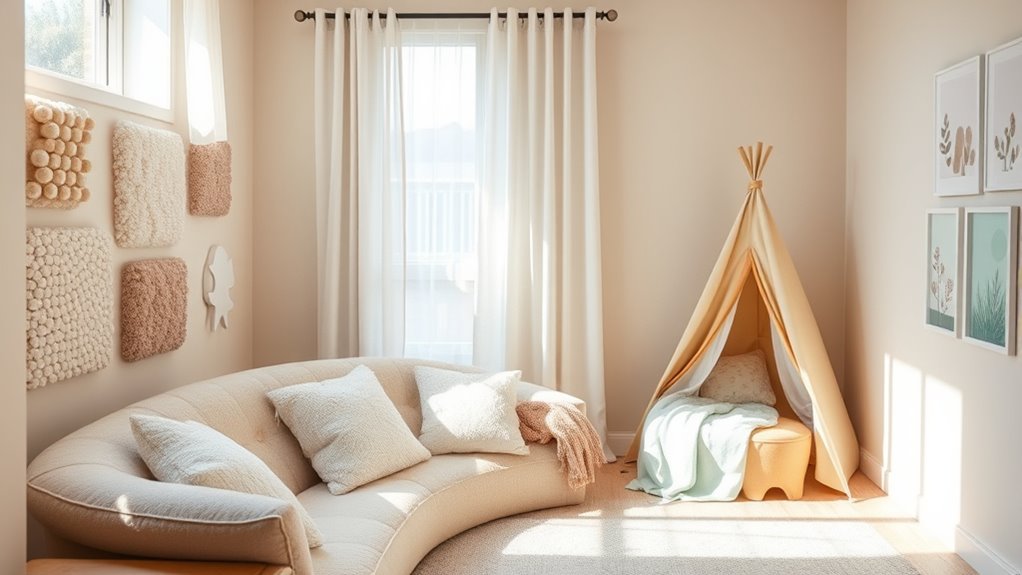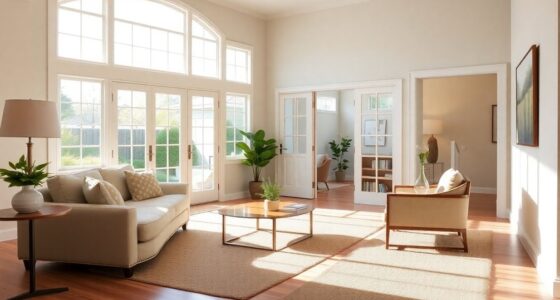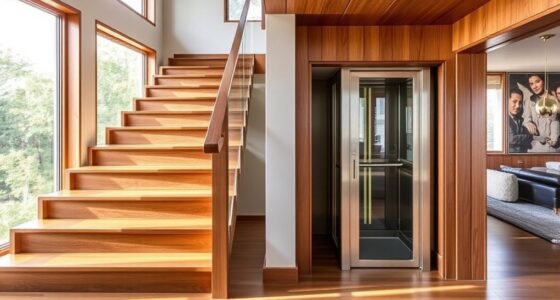To create a sensory-friendly home for autism and special needs, prioritize soft, adjustable lighting like warm bulbs, dimmers, and natural light control to prevent overloads. Choose calming textures such as plush fabrics and natural fiber rugs, avoiding rough or busy patterns. Incorporate cozy, weighted items and simple, clutter-free spaces that foster safety and relaxation. These thoughtful touches help reduce stress and improve comfort; keep exploring to discover more ways to tailor your space.
Key Takeaways
- Use soft, adjustable lighting like dimmable lamps and warm-colored bulbs to create a calming environment.
- Incorporate tactile-friendly textures such as fleece, cotton, and natural fibers to promote comfort.
- Minimize sensory triggers by avoiding flickering fluorescent lights and cluttered textures.
- Provide control options like dimmer switches and window shades to customize lighting and environment.
- Design spaces that promote safety and relaxation through thoughtful lighting, textures, and sensory regulation features.

Creating a sensory-friendly home involves designing spaces that reduce overwhelm and promote comfort for those sensitive to sensory input. One of the most impactful ways to achieve this is by carefully selecting your lighting options. Bright, harsh lights can easily trigger discomfort or sensory overload, so opting for soft, adjustable lighting is essential. Consider using dimmable lamps, warm-colored bulbs, or indirect lighting that can be easily modified to suit individual needs. Incorporating options like fairy lights or shaded lamps helps create a calming atmosphere without overpowering the senses. Additionally, avoid fluorescent lighting, which often produces flickering that can be unsettling. Instead, prioritize natural light during the day, using blackout curtains or shades to control intensity and prevent glare. By thoughtfully controlling lighting, you help create a space that feels safe and soothing. Using filtering options such as window shades or specialized bulbs can further reduce sensory triggers linked to lighting. Incorporating lighting controls that allow easy adjustment can empower individuals to tailor their environment at any moment, fostering a sense of autonomy. Adjustable lighting fixtures can also accommodate changing needs throughout the day or activity. When selecting lighting, consider how lighting quality impacts mood and sensory comfort, as different types can produce varying effects. Texture choices are equally essential in establishing a sensory-friendly environment. Different textures can either comfort or overwhelm, so it’s important to select materials that promote tactile calmness. Soft fabrics like cotton, fleece, or velvety textiles work well for bedding, cushions, and furniture covers because they feel gentle against the skin. Incorporate textured rugs or mats made of natural fibers to add tactile variety without being abrasive. Avoid rough or scratchy materials that could cause discomfort or irritation. In spaces meant for relaxation, consider adding weighted blankets or plush throws, which provide comforting pressure. When choosing textures, think about consistency and simplicity—cluttered or overly varied textures can create sensory overload. Instead, aim for a harmonious mix that fosters a sense of calm and comfort, allowing the individual to feel more grounded. Combining thoughtful lighting options with carefully chosen textures creates an environment that minimizes sensory triggers and maximizes comfort. These choices aren’t just about aesthetics; they’re about fostering a space where someone with sensory sensitivities can feel secure and at ease. Remember, the goal is to create a home that adapts to individual needs, offering control over sensory input. By paying close attention to how lighting affects mood and how textures influence tactile comfort, you’re making a significant step toward a truly sensory-friendly home. Every detail, from the dimming switch to the softness of the cushions, contributes to an environment that promotes calmness and well-being. Your effort in designing such spaces can profoundly impact comfort, safety, and overall quality of life for those with autism or other sensory sensitivities. Creating sensory-calming environments further enhances the home’s ability to support sensory regulation and emotional resilience.
Frequently Asked Questions
How Can I Customize Lighting for Sensory Sensitivity?
You can customize lighting by using adaptive lighting systems that adjust brightness and color temperature to suit your needs. Incorporate color customization options to create a calming environment or reduce overstimulation. Dimmable lights and smart bulbs give you control over lighting levels, helping you manage sensory sensitivities effectively. By tailoring lighting with these features, you create a comfortable space that supports your sensory comfort and daily routines.
Which Materials Are Best for Noise Reduction?
Think of noise reduction materials as a calm shield for your space. You should consider soundproof curtains, which block out unwanted noise, and acoustic panels, designed to absorb sound waves. These materials create a peaceful environment by minimizing echo and external sounds. Using them strategically in your home helps provide a quieter, more comfortable space, perfect for relaxing or focusing without distractions.
How Do I Create Calming Sensory Corners?
To create calming sensory corners, start by choosing soft, cozy cushions and calming visual aids like soothing pictures or gentle lights. Add fidget toy ideas like stress balls or textured items to keep hands busy. Keep the space quiet and free of distractions, encouraging relaxation. You can also include calming scents or gentle music to enhance the peaceful atmosphere, making it a safe retreat whenever needed.
What Are Affordable Sensory-Friendly Decor Ideas?
You can create affordable sensory-friendly decor ideas by focusing on calming visual textures and soothing color schemes. Use soft blankets, textured pillows, or wall art with gentle patterns to add tactile and visual comfort. Stick to neutral or pastel colors to promote relaxation, and incorporate inexpensive items like string lights or fabric panels. These simple updates make your space more inviting and calming without breaking the bank.
How Can I Incorporate Technology to Aid Sensory Needs?
Imagine a gentle guiding hand helping you navigate sensory challenges. You can incorporate technology by adding assistive gadgets, like noise-canceling headphones or calming lights, to create a soothing environment. Virtual reality offers immersive experiences that can gently expose someone to sensory inputs at their own pace. These tools empower you to tailor your space, making it more comfortable and supportive for sensory needs, fostering calm and confidence.
Conclusion
Creating a sensory-friendly home can markedly improve daily life for individuals with autism and special needs. By reducing overstimulation and designing calming spaces, you help foster comfort and independence. Did you know that nearly 90% of parents report that sensory-friendly modifications positively impact their child’s behavior and well-being? With small adjustments, you can make a big difference. Start today, and watch your space transform into a safe, nurturing haven tailored to their unique needs.









